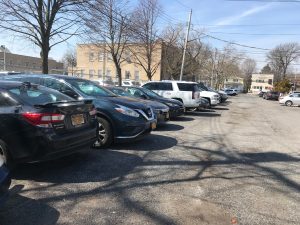Staten Island Dem Hopeful Wants to Keep Speed Cameras — And Spend the Revenue on Safety Improvements

A candidate for the city’s southernmost Council district says she figured out a way to get Staten Island’s car-centric citizenry on board with automated speeding and red-light ticketing — by ensuring the money raised through such tickets be used to make streets safer for everyone in the borough.
Democrat Olivia Drabczyk, a public school teacher challenging speed demon Republican Joe Borelli in November for the Island’s 51st Council seat, said that the millions of dollars in fines issued by traffic-enforcement cameras on the Rock should be used for such safe-streets initiatives as building sidewalks where they don’t exist, increasing the amount of bike lanes on the island, and adding neck-downs at dangerous intersections.
“If the goal of the cameras is to make our streets safer, we can make sure the money they collect goes toward permanent infrastructure to do just that,” she said oj Tuesday morning at the corner of Jolene Street and Hylan Boulevard, Staten Island’s own Boulevard of Death.
Presently, all money collected through red-light and speed cameras goes into the city’s general fund — and it is a significant amount. In the first month of January, 2020, more than 23,000 violations were issued on Staten Island, amounting to more than $1 million in fines. Later that year, one South Shore camera alone, on Amboy Road and Woodhull Avenue, brought in more than $270,000.
The council candidate said her law would insist all money brought in from cameras be used in the boroughs where the cameras are placed, a move that will ensure local residents are guaranteed to get something back for their behind-the-wheel transgressions. Drabczyk’s commitment to street safety is a bit double-edged; she sympathizes with her would-be constituents on Staten Island who believe the city installs school-zone speed cameras simply to raise money.
“By requiring street camera revenue to stay in-district, it will disincentivize the city from installing more cameras,” she said. “In no way are we suggesting the city should increase the amount of traffic cameras on Staten Island.”
Drabczyk said she got the idea for her plan after seeing a study that revealed Staten Island is the most dangerous place in the country for pedestrians, with 11 times the nation average of citations issued to drivers for failing to yield to walkers.
Her campaign then organized a block-by-block audit of all 14 miles of Hylan Boulevard, which revealed significant safety issues for pedestrians, particularly in the bucolic southern section of the island.
At the corner of Hylan and Jolene, the site of two memorials to victims of traffic-related deaths, unwalkable sidewalks fade into woodlands and walkable ones simply end. There are no bike lanes despite the fact the road is at its widest and there is a public pool nearby, forcing some bicyclists to ride against traffic as they head south.
Notably, Mayor de Blasio recently reduced the speed limit on this portion of Hylan from 40 miles per hour, the highest in the city for a local street, down to 30. Many drivers complained, but Drabczyk says a lower speed limit isn’t enough.
“The truth is, the money we pay in fines for violations caught by cameras is enough to finance a massive sidewalk improvement and pedestrian safety program,” she said. “Ultimately, those physical improvements would not only improve safety for pedestrians on Staten Island, but also counteract the bad street design that encourage speeding.”
Drabczyk admits getting those sidewalks built would not be an easy task. Sidewalks along park land, for instance, require cooperation between both the Parks Department and the Department of Transportation — two different agencies with their own budgets — and it is difficult getting two agencies to cooperate on an expensive problem, she said.
Drabczyk also hopes to make her legislation more palatable to Island residents by having it switch the burden of sidewalk repair and replacement from homeowners to the city. Presently, the city only pays for a sidewalk damaged by a city-owned tree.
“Installing and repairing sidewalks is a costly endeavor for homeowners,” she said. “The city should be footing the bill for these repairs, and street camera revenue is one way to do it.”
Red-light and speed cameras have long been a hard sell on Staten Island, the borough least served by mass transit where the majority of residents are drivers. Many see the violation fees as an additional tax, and some have taken to warn drivers of cameras ahead by tying ribbons around poles and putting up signs — a practice that Streetsblog sought to thwart, and also inspired the seminal Streetsblog song parody, “Tie a Yellow Ribbon ’Round the Camera Pole.”




